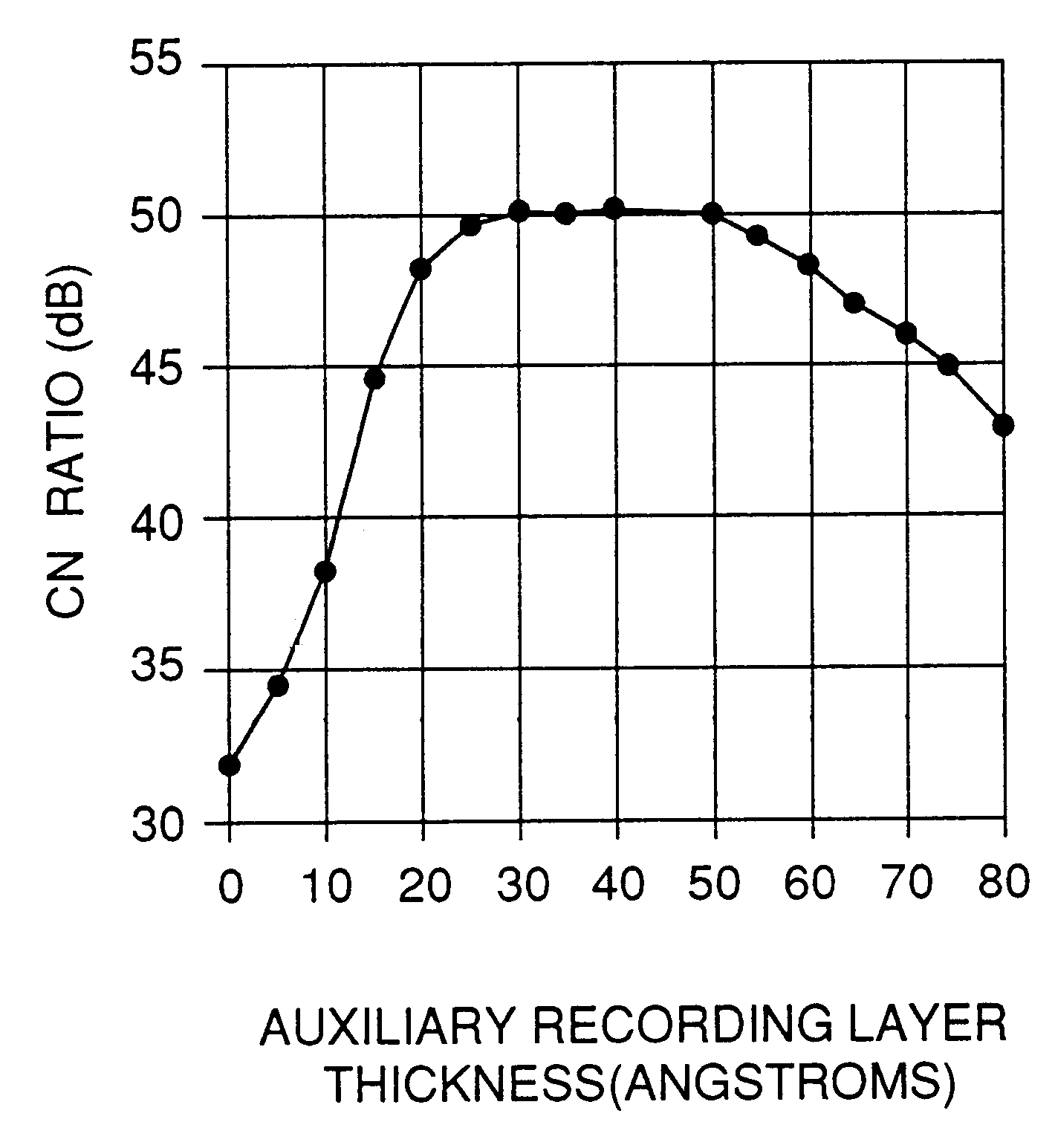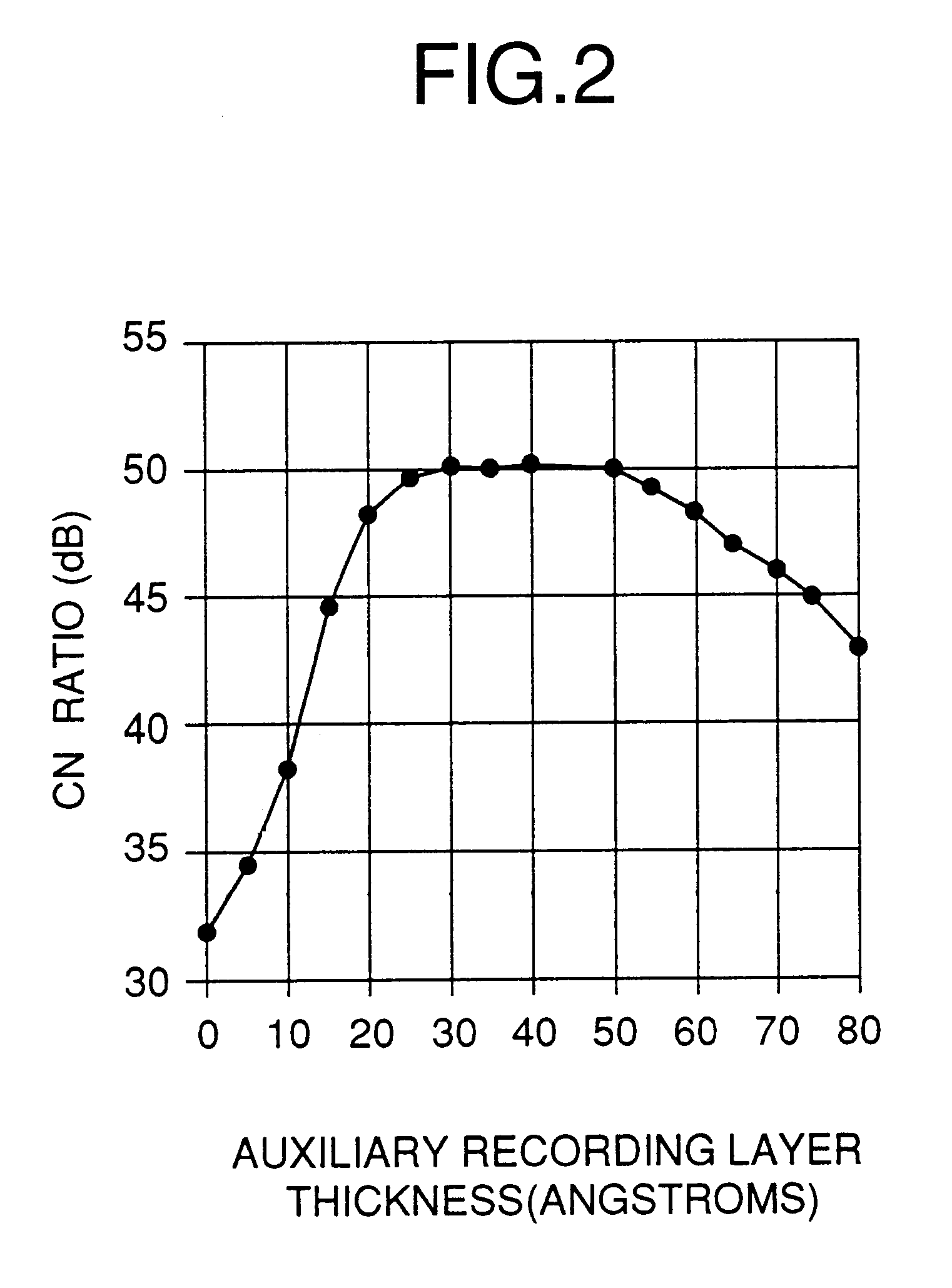Magneto-optical recording medium
a magnetic field and recording medium technology, applied in the field of magnetic field recording medium, can solve the problems of deteriorating the characteristics of reproduced signals, difficult in practice to lower the required intensity of the modulation magnetic field below 100 oersteds, and difficult to accurately control the recording mark control with optical modulation methods
- Summary
- Abstract
- Description
- Claims
- Application Information
AI Technical Summary
Benefits of technology
Problems solved by technology
Method used
Image
Examples
embodiment 1
1. Embodiment 1
FIG. 1 shows the sectional structure of a first embodiment of the magneto-optical recording medium suitable for recording by a magnetic field modulation method of the present invention. A first dielectric layer 12, a recording layer 13, an auxiliary recording layer 14, a second dielectric layer 15, and a reflective layer 16 are sequentially laminated upon the surface of a transparent substrate 11. The recording layer 13 and the auxiliary recording layer 14 are rare earth-transition metal alloys. The Curie temperature of the auxiliary recording layer 14 is greater than that of the recording layer 13.The thickness of the auxiliary recording layer is less than or equal to 100 angstroms. The exemplary materials for these layers are as follows: the transparent substrate 11 is poly carbonate (PC) substrate; the first dielectric layer 12 and the second dielectric layer 15 are layers of Al--Si--N; the recording layer 13 is a layer of Tb--Fe--Co; the auxiliary recording layer ...
embodiment 2
2. Embodiment 2
FIG. 11 shows the sectional structure of a magneto-optical recording medium of this embodiment. A first dielectric layer 12, an auxiliary recording layer 14, a recording layer 13, a second dielectric layer 15, and a reflective layer 16 are sequentially laminated upon a transparent substrate 11. Thus, the only difference as compared with the medium which was shown in FIG. 1 is that the order of superimposition of the recording layer 13 and the auxiliary recording layer 14 is opposite.
(1) Experiment 6: Relationship between the film thickness of the auxiliary recording layer 14 and the magnetic field sensitivity.
Here, a rare earth-transition metal alloy having the composition Tb0.15(Fe0.91Co 0.09)0.85 was used as the recording layer 13. This layer 13 was formed by DC magnetron sputtering, using a target manufactured by alloy casting, under the following conditions: argon gas pressure 1.8 mTorr; and supplied power 300 W. Its Curie temperature was 190 C.
A rare earth-transi...
embodiment 3
3. Embodiment 3
FIG. 13 shows the sectional structure of a magneto-optical recording medium of this embodiment. In this embodiment, the auxiliary recording layer is interposed in the space between two recording layers 13-1 and 13-2. In other words, a first dielectric layer 12, a first recording layer 13-1, an auxiliary recording layer 14, a second recording layer 13-2, a second dielectric layer 15, and a reflective layer 16 are sequentially laminated upon a transparent substrate 11.
(1) Experiment 7: Relationship between the film thickness of the auxiliary recording layer 14 and the magnetic field sensitivity.
Here, a rare earth-transition metal alloy having the composition Tb0.16(Fe0.8Co 0.20)0.84 was used for the recording layers 13-1 and 13-2. These layers 13-1 and 13-2 were formed by DC magnetron sputtering, using a target manufactured by alloy casting, under the following conditions: argon gas pressure 1.8 mTorr; and supplied power 300 W. Their Curie temperature was 240 degrees ce...
PUM
| Property | Measurement | Unit |
|---|---|---|
| thickness | aaaaa | aaaaa |
| Curie temperature | aaaaa | aaaaa |
| Curie temperature | aaaaa | aaaaa |
Abstract
Description
Claims
Application Information
 Login to View More
Login to View More - R&D
- Intellectual Property
- Life Sciences
- Materials
- Tech Scout
- Unparalleled Data Quality
- Higher Quality Content
- 60% Fewer Hallucinations
Browse by: Latest US Patents, China's latest patents, Technical Efficacy Thesaurus, Application Domain, Technology Topic, Popular Technical Reports.
© 2025 PatSnap. All rights reserved.Legal|Privacy policy|Modern Slavery Act Transparency Statement|Sitemap|About US| Contact US: help@patsnap.com



